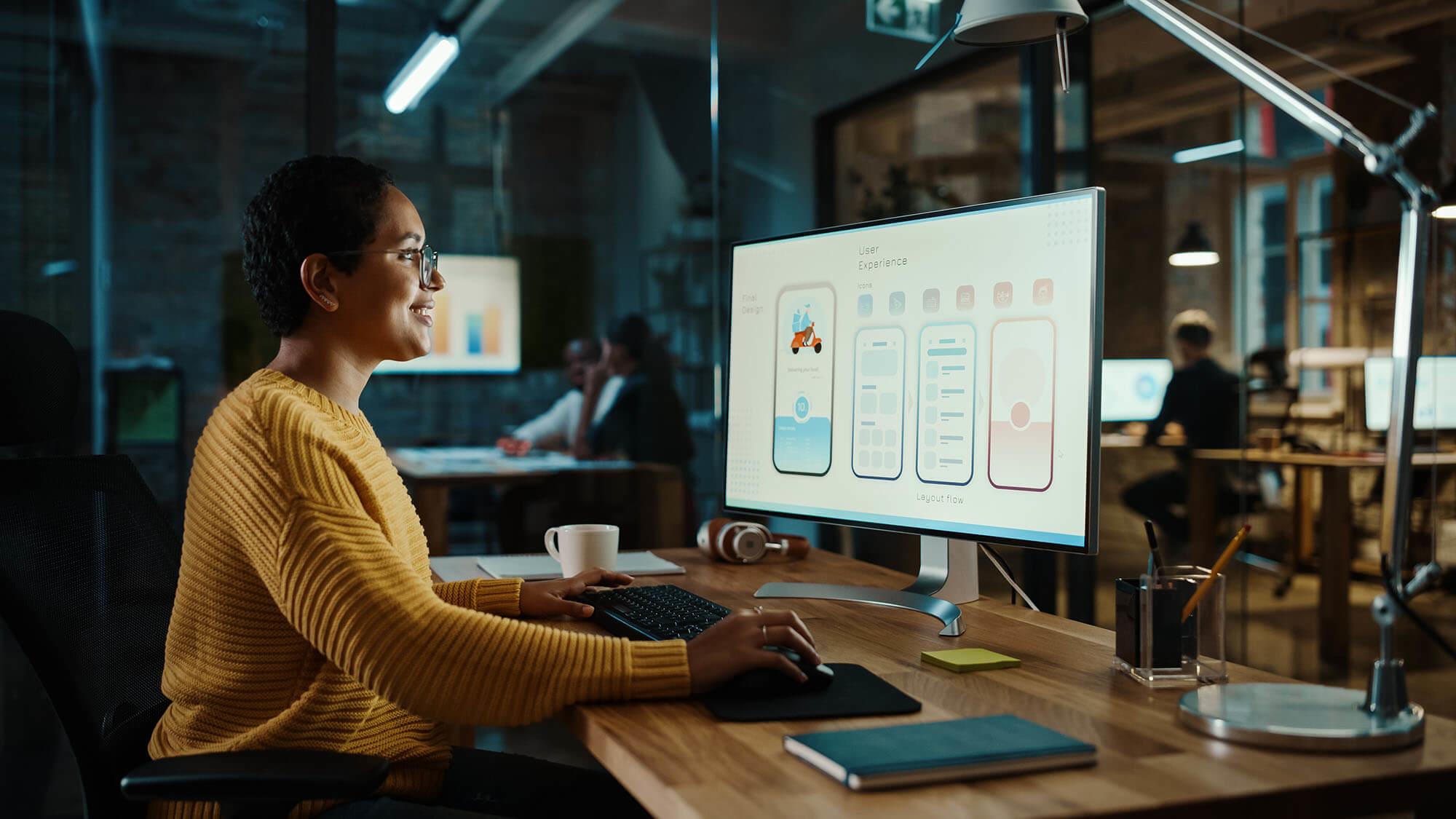Web Design London Ontario Agency for Online Success
Web Design London Ontario Agency for Online Success
Blog Article
Exactly How to Properly Incorporate Looks and Functionality in Web Layout
When making a website, you require to strike an equilibrium in between looks and capability. It's not simply regarding looking excellent; your design should additionally serve a purpose and overview customers successfully. By concentrating on simpleness and instinctive navigation, you can create an engaging experience. Yet what elements truly improve usability while maintaining aesthetic allure? Let's check out the essential concepts that can result in a harmonious mix of beauty and feature.
Recognizing the Importance of Aesthetic Appeals and Functionality
Understanding the balance in between looks and capability is important for creating an effective customer experience when you design a site. An aesthetically attractive website grabs focus, yet it's the performance that keeps users involved. If your site looks wonderful but is hard to browse, visitors will quickly weary and leave.Consider your target audience and what attracts them in. You intend to produce a design that mirrors your brand name while guaranteeing simplicity of usage. Streamlined designs, user-friendly navigating, and clear phone call to activity can enhance both visual appeals and performance.

Principles of Reliable Website Design
To create a reliable web style, you require to comply with numerous crucial principles that enhance both customer experience and visual allure. Prioritize simplicity; a tidy layout aids individuals browse quickly. Use a consistent color scheme and typography to maintain comprehensibility throughout your website. This promotes familiarity and trust.Next, assure your style is responsive. Customers accessibility web sites on different devices, so your layout should adjust seamlessly. Focus on visual power structure; highlight essential aspects with size, color, or positioning to lead users' focus.Finally, include adequate white area. It prevents clutter and makes content a lot more absorbable. Remember, effective internet style balances visual appeals and performance, so every design choice must offer a function. By following these concepts, you'll create a site that's not just visually attractive but additionally user-friendly, ultimately maintaining site visitors involved and urging them to return.
Focusing On Individual Experience
When focusing on customer experience, you'll wish to start by understanding what your users absolutely require. Streamlining navigating style can make a significant difference in just how conveniently they locate what they're trying to find. Additionally, boosting aesthetic hierarchy aids direct their interest to the most essential components on your website.
Recognizing Customer Demands
Recognizing customer demands is vital for creating an interesting web experience that keeps visitors coming back. To attain this, you should identify the objectives and preferences of your target audience. Begin by performing customer research study, like meetings or studies, to gather insights on what customers worth most. When connecting with comparable websites, pay focus to their pain points and difficulties. This details permits you to customize your layout, ensuring performance straightens with customer assumptions. Furthermore, think about developing user characters that stand for different segments of your audience, helping you imagine their demands during the style process. When you focus on recognizing individual demands, you develop a website that not only looks fantastic but also delivers a smooth, enjoyable experience that cultivates commitment.
Simplifying Navigation Layout

Enhancing Aesthetic Hierarchy
A solid aesthetic power structure is necessary in directing users with your internet site and ensuring they engage with key web content. To attain this, use spacing, size, and color strategically. Make vital elements like headings bigger and bolder than body text, drawing interest instantly. Utilize contrasting colors to highlight phone calls to activity, urging clicks. In addition, utilize adequate white space to separate sections, making content absorbable and inviting.Consider the circulation of details; organize elements realistically, leading individuals' eyes from one factor to the following. Usage visual cues, like arrows or lines, to route focus. By prioritizing aesthetic hierarchy, you improve individual experience and boost the chance of conversions, guaranteeing your web site is both aesthetically pleasing and functionally reliable.
Shade Theory and Its Effect On Use
While choosing the ideal colors for your internet site might look like a minor detail, it significantly influences functionality and individual experience. Color impacts exactly how customers perceive details and can improve or hinder navigating. Contrasting colors can assist vital elements stand out, making it less complicated for site visitors to locate what they need.Additionally, consider the psychology of shades: blue usually influences trust fund, while red produces necessity. Recognizing your target market can assist your shade options, ensuring they reverberate well.Moreover, regular color pattern assist build brand identity, making your site more memorable. However, beware-- a lot of colors can bewilder customers. Adhere to a restricted scheme that enhances your material and keeps clarity.Incorporating ease of access is also essential; confirm your shade mixes are friendly for those with aesthetic impairments. By attentively applying shade concept, you'll improve usability and produce a more engaging user experience.
Typography: Balancing Style and Readability
Shade selections set the stage for your internet site, but typography plays a just as necessary duty in enhancing individual experience. You want your message to connect clearly while also showing your brand name's individuality. Start by choosing font styles that are not only attractive yet likewise readable. Sans-serif fonts often work well for digital displays, as they're simpler to read at various sizes.Maintain a power structure by utilizing various font style sizes and weights; this guides users with your material effortlessly. Take into consideration line spacing and letter spacing; as well limited can irritate visitors, while also loose can disrupt the flow. Restriction your font options to two or 3 to keep the layout cohesive.Finally, always check your typography throughout different devices and browsers. What looks great on one display may not on another. Stabilizing design with readability warranties that your message resonates, maintaining your target market engaged and informed.
Receptive Layout: Making Aesthetics Work With All Tools
To guarantee your website looks wonderful on any kind of tool, you'll require to welcome responsive design principles. This approach assurances your site adapts to numerous display sizes, supplying an ideal individual experience. Start by making use of liquid grids and versatile photos that scale flawlessly. Rather of dealt with measurements, choose percents and relative systems, allowing your design to change dynamically.Next, execute media queries in your CSS. These let you apply different designs based upon device features, like display size. In this manner, you can preserve visual charm while assuring functionality.Don' t forget touch targets; ensure buttons and links are simple to touch on smaller sized displays. Focus on essential content, so individuals can conveniently navigate your site regardless of their tool. By concentrating on these elements, you'll develop an interesting, visually appealing experience that satisfies the requirements of all individuals, whether they're on a smart device, desktop computer, or tablet computer .
Performing Use Testing for Continuous Improvement
To improve your internet layout, you need to establish clear usability goals that line up with user requirements. By performing user examinations, you can gather valuable comments on just how genuine people interact with your site. Analyzing these results will certainly aid you make notified improvements and produce a more efficient individual experience.
Defining Use Goals
While appearances can draw individuals in, specifying usability objectives is essential for guaranteeing their experience remains seamless and satisfying. Begin by determining what you want customers to achieve on your website (website design london Ontario). Consider their tasks, demands, and actions. Are they looking for information, making an acquisition, or registering for an e-newsletter? Establish clear standards to gauge success, like job conclusion prices or time on task. Focus on intuitive navigation, accessible content, and receptive style to enhance use. Frequently take another look at these goals as customer assumptions advance. By defining use goals, you develop a framework for assessing and improving your website's performance. This concentrate on functionality not only boosts user complete satisfaction but likewise reinforces the total effectiveness of your design
Performing Customer Examinations
Performing customer tests is crucial for refining your internet site and guaranteeing it fulfills your target market's requirements. Begin by recognizing your target individuals and creating an examination strategy that details your purposes. Make use of a mix of qualitative and measurable methods, such as studies, interviews, and task-based observations, to gather complete responses. Invite individuals to browse your site while you observe their interactions and keep in mind any type of difficulties they come across. Motivate open discussion to catch their ideas and feelings regarding the layout and functionality. Maintain sessions short and concentrated, ensuring you cover essential areas without overwhelming individuals. Make certain to document all searchings for, as this information will be indispensable for making informed style choices that boost both aesthetics and use.
Assessing Test Outcomes
How can you successfully analyze the results of your functionality tests to drive continual renovation? Beginning by classifying responses right into common styles. Try to find patterns in customer actions that highlight pain factors or areas for enhancement. Usage measurable data, like task completion rates and time on task, to gauge usability objectively. Don't neglect to consider qualitative understandings from individual remarks; they typically expose underlying problems that numbers read more can't reveal. Prioritize the most impactful searchings for and create actionable things for your design group. Remember, it has to do with iterating-- execute modifications, then test once again. This cycle of testing, assessing, and refining assists you balance visual appeals and functionality, guaranteeing your web site fulfills individual demands properly while maintaining visual appeal.
Often Asked Questions
How Do I Select the Right Shade Scheme for My Site?
To choose the best color scheme for your website, consider your brand's character, target audience, and psychological effect (website design london Ontario). Use color psychology, develop consistency, and assurance readability. Test mixes to see what reverberates ideal with site visitors
What Tools Can Assist With Internet Layout Aesthetic Appeals and Performance?
You can utilize tools like Adobe XD, Figma, and Sketch to enhance your web layout's aesthetics and functionality. These systems supply instinctive interfaces, partnership features, and pre-made layouts to improve your imaginative process and improve your designs.
How Can I Include Animations Without Compromising Performance?
To incorporate animations without jeopardizing performance, prioritize subtle impacts that enhance individual experience. Use CSS computer animations for smoother interactions, assurance quick lots times, and examination on numerous gadgets to maintain efficiency while adding visual allure.
What Are Usual Errors to Avoid in Internet Design Aesthetics?
When creating, avoid cluttered formats, inadequate color selections, and inconsistent font styles. Do not ignore mobile responsiveness, as it can estrange customers. Verify your design aligns with your brand, developing a smooth experience that engages visitors efficiently.
How Frequently Should I Update My Site's Design for Optimal Appearances?
You need to upgrade your internet site's layout every 1-2 years to maintain up with patterns and keep excellent aesthetics. Regularly renewing visuals helps engage guarantees and site visitors your site continues to be user-friendly and attractive. When you make a site, comprehending the equilibrium in between visual appeals and functionality is important for producing an effective user experience. To produce an effective internet layout, you need to adhere to a number of key concepts that enhance both customer experience and visual allure. Users access web sites on various tools, so your style should adapt effortlessly. When prioritizing customer experience, you'll want to start by comprehending what your customers genuinely require. Begin by conducting user research study, like surveys or meetings, to gather insights on what customers value most.
Report this page